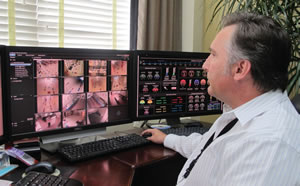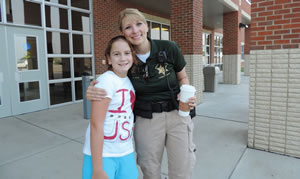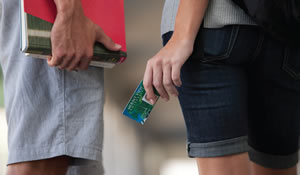Access Control Systems
Train, train and train some more.

PHOTOS COURTESY OF WILLIAMSON COUNTY SCHOOLS.
“We constantly hear from school administrators that they receive frequent communication from parents asking what’s being done to protect their students while at school,” says Nils Wahlander, senior Product Marketing manager with Irvine, Calif.-based HID Global, which provides access control and secure identity solutions. “With some of the incidents in recent years in schools, there’s a heightened sense of knowing who each person is at a school, in order to protect faculty and staff as well as students.
One way HID assists schools in protecting building occupants is with visitor management software. It allows administrators to create and manage badge templates by category; create and manage all of the user accounts for the employees who will be operating the badging software in each building; set up and manage an automated, scheduled employee import process, ensuring the visitor list is always updated; and manage all setting and options on each badging station from the central administrator console.
Visitor management software, among other physical security measures, is employed at Oak Park And River Forest High School (OPRF), a standalone high school district in Oak Park, Ill., boasting 3,600 students in grades 9-12 on one campus that includes one million square feet of property.
“We have digital camera systems that can be remotely viewed on computers, both on and off campus,” says Randy Braverman, director of Campus Safety. “In 20 areas on campus, where it is challenging to hear the PA system, such as the field house, pool and gyms, we have a colored light system. Red means hard lock down, clear is fire and yellow is shelter-in-place or drill. Because we have an open campus, we have six red lights on corners of the building. If the light is on, students returning to campus from lunch know there’s a hard lock down and not to come on campus. There’s a panic button at the front desk. We have a radio system where police and fire dispatch can contact the district directly without using the phone and we can contact them without dialing 911. Also, we have cameras at access control points so that, if someone leaves a door propped open, we know who did it.

People are Important. Longview Elementary School Resource Officer Becky Coyle greets a student before school. Being familiar with all of the students is the ideal situation, but not possible in many cases, so schools also need to use physical security equipment. The equipment is useless if personnel aren’t trained to use it. That training needs to be continual, repetitive, intentional and backed up by effective policies and procedures.
“We have a new system in place for evacuating physically challenged students,” Braverman continues. “There are five designated areas where those students report during an evacuation, and first responders know to go to those rooms to rescue them. And we have special alerts to notify staff if something is going on, such as bicycles being broken into, so they can be on the lookout for suspicious activity.”
With approximately 34,000 students on 41 school sites: nine high schools, eight middle schools, 23 elementary schools and one K-8 school, Williamson County Schools (WCS) in Franklin, Tenn., is about 10 times larger than OPRF. Superintendent Dr. Mike Looney acknowledges that that’s a lot of students and facilities to keep safe. Just like Braverman, he does it with a host of security strategies.
“We have video surveillance systems with live feeds to emergency responders and district administration,” Looney says. “For example, right now I am physically looking at a live video feed of all our elementary school campuses. That availability is also provided to law enforcement, even in their patrol cars, through a secure portal. Our principals have access to the video surveillance equipment on their personal devices, such as ipads and/or smart phones. They can be roaming a hallway and look up a student’s information, including name, picture, telephone, address and emergency contact.
“We have installed two-way radio communication systems throughout the district with direct link access to both EMA/911 and my office,” Looney continues. “Post-Sandy Hook, we have hired a safety and security director, are installing controlled access points on every campus and have sheriff deputies patrol our campuses. With law enforcement and first responders, we have prepositioned first response equipment on all of our campuses.” Both men have been thoughtful and thorough when it comes to the safety of building occupants. Yet, as Looney says frankly, “You’re probably not ever thorough enough.”

PHOTO COURTESY OF HID GLOBAL
In the cards. Effective access control systems include technology, people, policies and training. In order to protect students and staff, it is helpful to know who is in the school, and certain areas of the facility, at all times. One way to do that is with ID cards.
Being thorough also means training because all the physical security equipment in the world is useless if personnel aren’t trained to use it. Mike Dorn, executive director of Safe Havens International, an international non-profit campus safety center based in Macon, Ga., observes that, sometimes administrators purchase technology, install it and expect problems to go away. “That’s an unrealistic expectation,” he says. “A better expectation, with more effective results, is to train and have policies.”
Dorn recalls an incident highlighting the need for training and policies at a school in Oklahoma that had experienced a shooting. “There was a metal detector in the main entryway, plugged into the wall with an extension cord, and a sign that read, ‘Please Walk Through the Metal Detector.’ There wasn’t a trained staff person in sight to operate the equipment or enforce school policies.”
Training staff
What then, should training look like? There are a number of facets.
1. It’s continual. Training is never a one-and-done event. Rather, it’s continual — once a week, once a month, whatever fits your organization. And it doesn’t have to be tedious or hours long. “Maybe we don’t have a boatload of time to devote to training,” says Paul Timm, PSP, president of Lemont, Ill.-based RETA Security, Inc., “so we’re going to remind people on a periodic basis and in bite-sized pieces. I do know this: If we can carve out three to five minutes from every meeting to do brief and engaging reminders in terms of training, it helps us keep or maintain a heightened sense of awareness. That’s key.”
2. It’s repetitive. Of course new staff receive training and everyone receives training on new equipment. Beyond that, training is repetitive. “Training is an ongoing process,” says Looney. “The radio system, for example, is only as good as you practice.” His district has regular radio checks with all employees. “If you’re not accustomed to pushing the button when talking, releasing it to hear and waiting for the delay, even though you’ve been shown, you may not be able to successfully operate it in a crisis,” he continues. “Similarly, with the video surveillance system, we teach how to pan, record, save and retrieve, as well as how to use it proactively to spot vehicles out of place.”
One of the reasons repetition in training is necessary is because security systems are not passive. “They have to be used actively,” says Looney, “which means establishing a culture in your school where it’s part of the daily work that, in a time of emergency, you’re not reflecting on how to use the equipment. Rather, using the equipment is automatic and you can use it in more efficient ways.”
Repetitive training is also a good way to correct issues that arise because, obviously, people forget what they’ve been shown but not put into practice. “We use videos, PowerPoints and demonstrations,” says Braverman. “All those methods are acceptable.”
3. It’s intentional. “I’ve seen situations where training is promised in the contract for a new video surveillance system,” says Timm, “but it’s never scheduled or completed, so staff don’t know how to use it. Training has to be intentional, such as scheduling that, on the first of the month, we’ll review the important parts of the system. The key word here is intentional. And there are numerous ways it can be accomplished. Instead of calling a two-hour meeting, maybe an online video can be viewed as each staff member has time, and I have accountability of knowing when it’s viewed so I can rest easy that staff have been engaged with it.”
Policies and procedures
What then, do policies and procedures look like? They’re written, thorough and clear. They don’t have to be created out of nothing — ask colleagues at neighboring districts for theirs and then tailor them to your needs.
Here’s why: Without them, training is impotent at best and invalid at worst. Dorn cites an example of a school district that had airport-style security, operated by well-trained staff, yet he was able to bypass the physical security measures and enter the building three days in a row. “This was a policy/practice issue,” he observes. “Poor regard for weak policies meant that staff was willing to prop doors open. This practice neutralized the effectiveness of the excellent equipment in place.”
As the above scenario indicates, once policies are written, they have to be put into practice. Dorn says that is accomplished by training staff and holding administrators accountable. “Training should be about what to do and also about why it’s done that way,” he says. “For example, ‘We do not prop doors open. If you do and someone gets in and harms a student, you’re responsible because you didn’t put safety in proper balance.’ Using a direct, professional approach, we have to teach staff what’s in it for them; we have to convince them that they have a personal stake in security.”
Timm validates Dorn’s wisdom by indicating how training and policy fit together. “I hate to say that one is more important than the other,” he notes, “but you can’t have good training until you have solid, documented practices. Otherwise everything subject to personal interpretation. For example, you’ll have some staff who are aware and conscientious and others who are minimalists, and you don’t want to leave that open to chance.”
Today’s school security technology is remarkably robust and user friendly. It’s amazing what it can accomplish. But, because it performs more tasks than in the past, it requires more training. “Training is incredibly important,” Dorn sums. “Almost always, the equipment is only as good as the operator.”
This article originally appeared in the issue of .